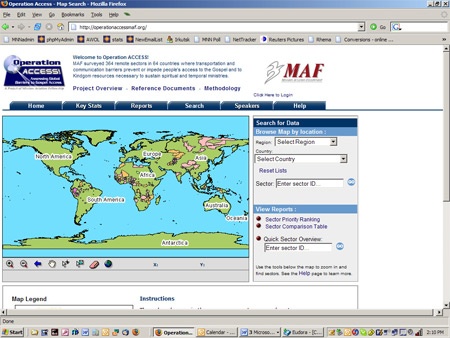 |
Key leaders from the world’s international missions organizations will be gathering at Mission Aviation Fellowship’s (MAF) new headquarters in Nampa, Idaho, USA 18-19 October to determine how to work together to effectively use the results of MAF’s recent landmark study “Operation ACCESS!” for global missions.
The Operation ACCESS! study, released in June, focuses on pockets of people who are forgotten or unreachable. It identifies areas where transportation, communications and technology barriers prevent or impede access to the gospel, or to sustained resources needed to enable community development, healthcare and education services. It also assesses the nature and significance of the barriers and the degree of any ministry taking place. There are also suggestions as to how the barriers can be overcome.
The five-year global research project provides critical, unprecedented information that will shape international evangelism, ministry and humanitarian strategies for the next twenty years. The potential impact of Operation ACCESS! has been likened to the “10/40 Window” strategy promoted by missions strategist Luis Bush.
Partnering Together
According to Dave Bochman, MAF chief operating officer and conference organizer, the Operation ACCESS! conference will be a “working meeting” of key decision makers from missions organizations, denominations and Christian non-governmental organizations from around the world. “
MAF’s aim is to partner with other organizations to use the study data to overcome barriers and reach the lost,” he said. “But we also want to facilitate other organizations working together and the development of collaborative strategies.”
Phil Butler, president of visionSynegy, an Edmonds, Washington, USA-based organization that develops strategic international Christian networks focusing on high impact opportunities for world evangelism, will facilitate the Operation ACCESS! conference.
Butler said Operation ACCESS! has the potential to shape worldwide evangelism strategies for the next ten years. “The issues facing us are on such a scale that they cannot be tackled by any individual or organization alone,” he said. “The Church must collaborate and work together.”
Kevin Swanson, MAF president, said research shows that despite the extraordinary missions efforts of the Church, three out of four people alive on the earth today still have not heard the gospel.
The Apostle Paul in Romans 10:14-15 talked about the need to send preachers. But preachers can’t be sent unless the barriers that prevent their access and sustainability are overcome,” said Swanson. “Operation ACCESS! is a strategic roadmap to accomplish this God-appointed task.”
Dr. Ralph Winter, founder of the US Center for World Missions, said, “MAF’s foundational re-analysis of its work and of mission work in general has produced a breathtaking new analysis of the challenge before us.”
![]() Dr. Charles Kraft, professor of anthropological and intercultural communication at Fuller Theological Seminary School of World Missions, called the study “one of the most promising projects I’ve seen in my thirty-two years at Fuller.”
Dr. Charles Kraft, professor of anthropological and intercultural communication at Fuller Theological Seminary School of World Missions, called the study “one of the most promising projects I’ve seen in my thirty-two years at Fuller.”
Operation Access Findings
Operation ACCESS! Surveys—which cover 364 remote sectors in sixty-four countries—found that transportation, communications or technology barriers prevent or impede people's access to the gospel, resources for spiritual growth and basic services.
 |
Key findings are as follows:
- Fifty-two percent of all sectors present “significant” barriers to reaching people living in the area.
- Sixty-six percent of all sectors had little or no ministry in place.
- “Significant” communications barriers are faced in eighty-nine percent of sectors; fifty-six percent of sectors face almost insurmountable communications barriers.
- Eighty-seven percent of sectors are difficult to access by road.
- Other barriers include: social and economic factors (seventy-five percent), agency resources factors (sixty-one percent), transportation and travel factors (twenty-three percent), political and religious factors (twenty-one percent) and geography factors (six percent).
- Fulfilling the task of the Great Commission demands that barriers be addressed and strategies deployed to overcome them and that they be developed in cooperation with indigenous and international missions groups.
- Surveys were conducted in fifteen of the twenty-seven countries where the top one hundred least-reached people groups live.
MAF Serving For More Than Fifty Years
Founded in 1945, MAF stations some two hundred missionary families in the remotest regions of twenty-three countries on five continents. MAF pilots fly approximately forty thousand flights a year, transporting missionaries, medical personnel, medicines and relief supplies, as well as conducting thousands of emergency medical evacuations. MAF also provides telecommunications services, such as satellite Internet access, high-frequency radios, electronic mail and other wireless systems, in isolated areas.
2006 marks the fiftieth anniversary of the death of MAF pilot Nate Saint, who, along with missionaries Jim Elliot, Ed McCully, Pete Fleming and Roger Youderian, was speared to death by Waodani (Auca) Indians in Ecuador.
For more information on the “Operation ACCESS!” conference, contact Ron Wismer at (in the US) 800-359-7623 or RWismer@maf.org.

